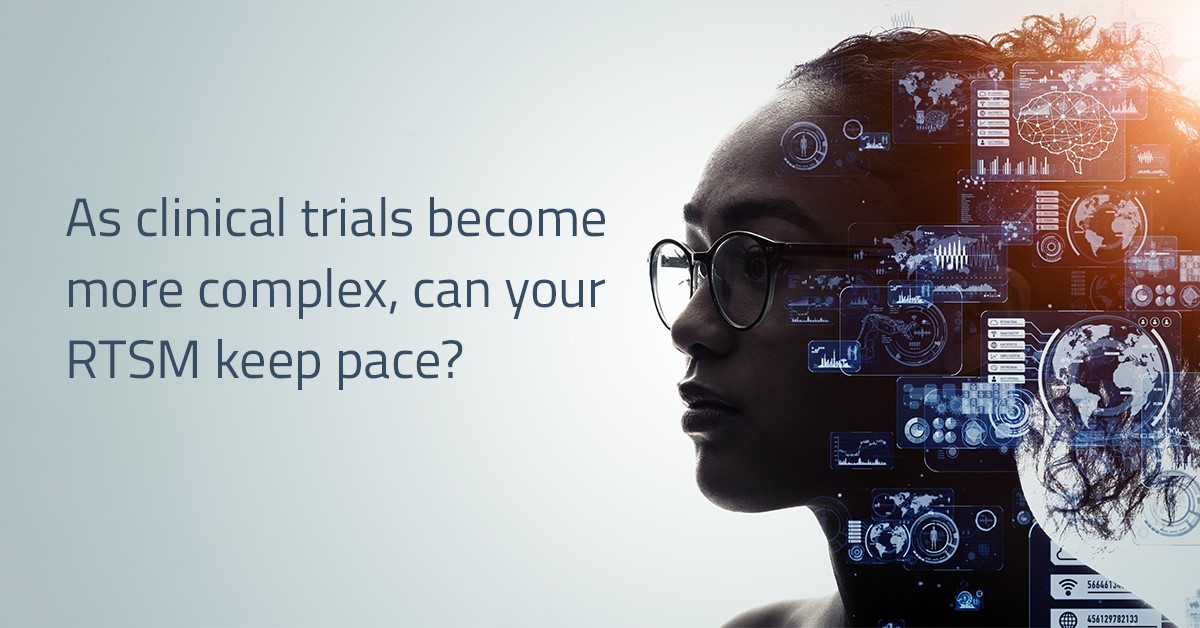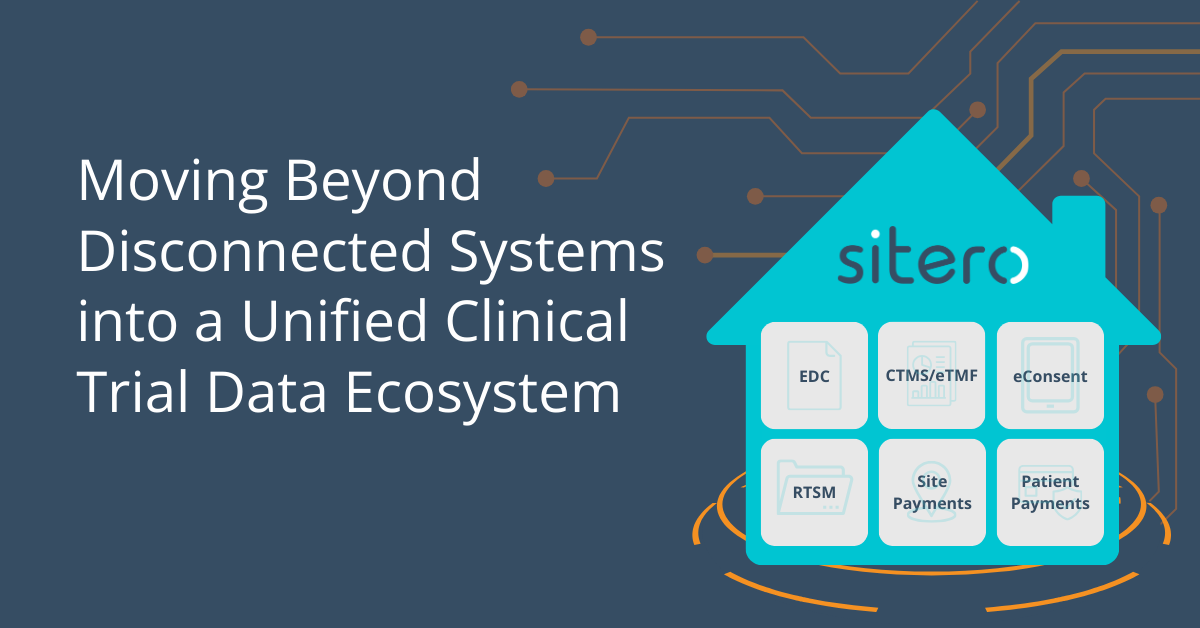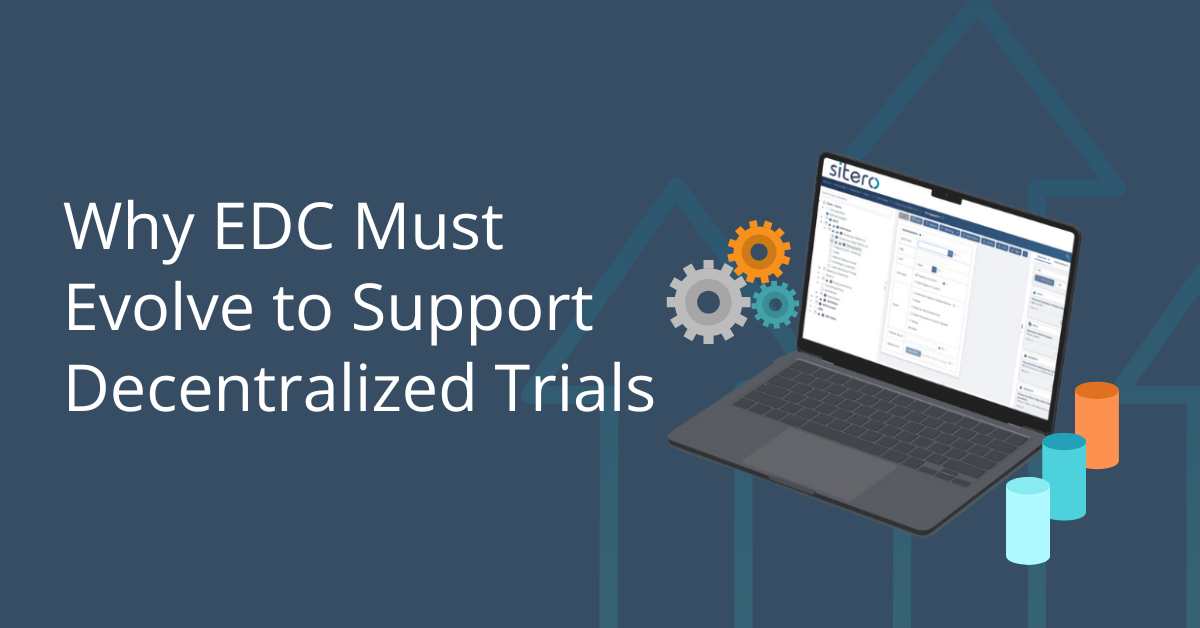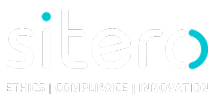
As Clinical Trials Become More Complex, Can Your RTSM Keep Pace?
Author: Kevin Bishop, VP, Corporate Strategy
Most everyone involved in clinical trials today can typically agree on one thing – clinical trial designs continue to become more and more complex! Several factors that have contributed to an acceleration of protocol complexity over the past 5 years includes the emergence and further development of:
- novel clinical trial designs
- master protocol designs
- seamless clinical trials (where one phase blends into the next)
- digital clinical trials
- and remote/hybrid trial designs (known as decentralized trials)
The second thing that most people involved in clinical trials will agree on, is that this complexity is likely to continue to accelerate as more sponsors adopt the approaches mentioned above and as regulators approve new products where these approaches have been used in their clinical development.
As the application of machine learning and artificial intelligence becomes more prevalent in clinical trials, with it comes the promise of the discovery of novel molecules, new therapeutic targets, and being able to use prior experience to push clinical trial design forward.
Key Considerations for RTSM
Randomization and Trial Supply Management (RTSM) is a clinical trial technology that oversees patient randomization and drug distribution. From an RTSM application perspective, the key question to address is: “Is your RTSM well positioned to keep pace with increasing clinical trial complexity?” Importantly, can your RTSM help sponsors and sites navigate the expanding technological landscape and the increasing volumes of clinical and operational data that will surely be a feature of future clinical trials?
There are several key questions and attributes that are often overlooked when selecting an RTSM partner. These elements will only continue to gain importance as clinical trial complexity continues to evolve in the coming years. To ensure success it is important that you evaluate the following when selecting an RTSM:
- How experienced is your Vendor?
- Is your RTSM fully capable?
- Is your RTSM quick to implement and quick to adapt?
- Is your RTSM interoperable?
- Can your RTSM surface actionable data?
- Is your RTSM able to interrogate the supply chain and optimize?
Vendor Experience is as Important as Technological Capability
As trial complexity increases, experienced vendors will work to understand how the protocol design may need to be adjusted during the trial in response to incoming clinical data. They will look to accommodate as much of this flexibility as they configure the first implementation thus reducing the time and effort for any mid-study changes or adjustments.
The key test of vendor experience is their ability to accurately translate a protocol into an RTSM configuration and, in doing so, ask the right questions early enough in the implementation cycle to deliver a precise design the first time with minimal need for rework.
The other area of vendor experience that will be critical to successful RTSM implementation is the ability for end-users to access support. Sites carry a heavy burden with respect to working across multiple technology platforms. Easy access to technology support in order to efficiently address any questions they have is critical. It is important to make sure your vendors’ support is truly available 24/7, is responsive, and can support the languages needed for your study.
RTSM Must be Fully Capable
It goes without saying that the RTSM system you use must have a functional capability to match the needs of your trial design. In RTSM, ‘customization’ (i.e., the writing of study specific code to incorporate a specific requirement not available in the core RTSM application) is often used to bridge the gap between system functionality and protocol/process requirements.
As trials become more complex, customization should be avoided as much as possible – it probably means the RTSM has not, or has rarely, supported the specific requirement before, and it could cause added challenges as the RTSM needs to be adapted as the trial progresses. At a minimum, make sure your RTSM can support:
- Advanced randomization/re-randomization methodologies
- Multiple subject cohorts
- Complex visit schedules and phases
- Complex dispensation regimen
- Different supply/re-supply modalities
- including direct-to-patient shipments, drug reconciliation, and returns
Equally as important is the vendor’s ability to continue to develop the core RTSM application and incorporate new functionality and enhancements as new use cases arise. As clinical trial designs rapidly evolve, this enables the RTSM application to remain fully capable of supporting emerging requirements without the need for per-study customizations.
RTSM Must be Quick to Implement and Quick to Adapt
Because of their inherently changing nature, both adaptive trial and master protocol approaches require highly sophisticated RTSM design capabilities and the ability to introduce protocol adjustments quickly and efficiently during study execution. With an experienced vendor coupled with a modern configurable approach to protocol implementation, RTSM should take around 4 weeks to implement for most protocols. This takes RTSM off the critical path for study start up activities.
Consider looking for experienced vendors that use an agile approach to RTSM implementation. They should be bringing a base configuration of your protocol to you early in the implementation cycle and allow you to interact with it as the discussions around design continue. This ensures that there are no surprises when they hand off the RTSM configuration to you for acceptance testing and that you are sufficiently familiar with the configuration to plan acceptance testing as efficiently as possible. Whenever possible, look for a full walkthrough of the RTSM configuration once it is completed.
The ability to be able to implement protocol adaptations and amendments into the RTSM configuration within days, and with minimal downtime, is another core attribute to look for in your RTSM vendor. Again, the avoidance of any customizations during the first implementation is key to success when needing to rapidly deploy changes to the RTSM design.
RTSM Must be Interoperable
In the era of the Digital Clinical Trial, RTSM must exist in an increasingly interoperable world. In fact, it is not uncommon for sponsors to want to carry out many RTSM transactions, such as randomization and drug dispensation, through a non-RTSM interface such as EDC (Electronic Data Capture), thus reducing site burden and complexity. Likewise, sponsors may wish to activate sites in RTSM following approval of the site in CTMS (Clinical Trial Management System), without the need to undertake a secondary RTSM approval transaction.
Traditional integration approaches (point-to-point) to eClinical integration do not easily support such capability. Look for a vendor that has published APIs against which such interoperability can be developed. For example, EDC may have a randomization form, which when saved, triggers RTSM to randomize the subject then return the randomization, or dispensation information, to the EDC interface for presentation to the EDC end-user.
Working with an RTSM vendor that has developed such an out-of-the box approach significantly reduces the time taken to integrate, which is typically pain point in RTSM/EDC implementation.
RTSM Needs to Surface Actionable Data
By implementing RTSM you have access to a lot of operational data concerning site, subject, and supply performance. From a site, study, or supply manager’s perspective the amount of data can be overwhelming, and a significant amount of time can be spent sorting and understanding the data to decide what actions needs to be taken (i.e., subject approaching end of a visit window, a re-supply shipment is 2 days past expected arrival date, etc.).
Often, significant effort (and money) is spent developing multiple custom reports that are designed to surface such anomalies for action. For a study or supply manager working across multiple protocols, this becomes a bigger challenge.
A better approach would be for the RTSM system to present the user with aggregated actionable data and alerts when they first log into the application. For example, having a dashboard that directs where they should focus their attention. For a supply manager this may include a listing of shipments requiring them to be packed or shipped, any reported temperature excursions, or any shipments which have not been confirmed as delivered after a pre-determined number of days. For a site this may include listings of outstanding shipments, subjects’ visits that are due or that appear to be over-due etc.
RTSM Needs to Interrogate the Supply Chain and Optimize
RTSM plays a vital role in deciding subject, site supply, and re-supply needs. The algorithms that drive this capability vary from simple ‘trigger’ levels to more sophisticated predictive approaches. Irrespective of the approach used, they provide the supply manager with a limited near-term view as to inventory requirements (i.e., what does each site requires for the next 2 weeks). The ability for a supply manager to see a basic forecast of a protocols supply requirements should be a core part of any RTSM application.
Increasingly organizations are using supply forecasting and optimization approaches to look over the immediate horizon to plan for future inventory requirements and to be able to appropriately plan batch releases and added packaging campaigns. More advanced RTSM systems can run simulations based on actual supply data and decide on any optimizations that should be applied to the study with respect to supply/re-supply parameters.
The goal of this is reducing wastage and shipment costs, as well as minimizing the possibility of running out of stock at a participating site, which is critical. Making sense of available data and then deciding how to optimize for the future is an early example of how Machine Learning may be applied in the RTSM space.
Importantly, such optimizations should be capable of being created from the actual RTSM study configuration, parameters, and data without the need to configure a separate study model for the simulation. The outcome of the simulation should be presented within the RTSM user interface and enable the study manager to easily apply suggested optimizations directly to the study supply parameters.
Conclusions
Clinical trials are complicated enough today. But what about the future? We will likely continue to see increasing sophistication of trial designs – driven both by science and the ability of supporting technologies to enable complexity.
We are already seeing machine learning being applied to optimize RTSM clinical supply chain configuration, but we may also be on the cusp of seeing other examples of machine learning and artificial intelligence being used to power a future generation of RTSM systems. Two obvious candidates would be:
- the ability to very rapidly (i.e., minutes not days) create an initial RTSM study configuration directly from the protocol and
- the ability to make sense of the operational data created by an RTSM and intelligently identify new risks, actions, or trends to surface to sites, study, and supply managers.
So, the question to ask yourself today, when working with RTSM vendors is: do they have the vision, platform, experience, and capacity to continue to keep pace with the needs of clinical trials tomorrow? Sitero offers a purpose-built, end-to-end, configurable RTSM solution that covers the full cycle of supply management from planning and forecasting, through inventory management. Contact us today to learn more.
The future of clinical trials is a unified, interoperable ecosystem. Sitero’s Mentor platform is leading this transformation, ensuring that clinical trials are more efficient, compliant, and streamlined than ever before. Learn more in our latest blog:
Today’s trials require data entry from anyone, anywhere including patients, sites, home nurses, and remote investigators. Learn why EDC systems must evolve to support decentralized trails in our latest blog:




